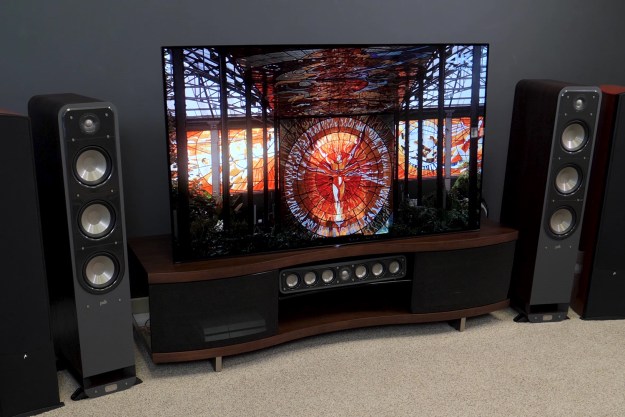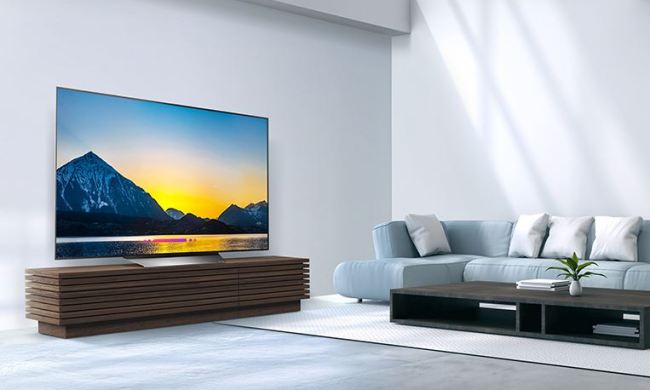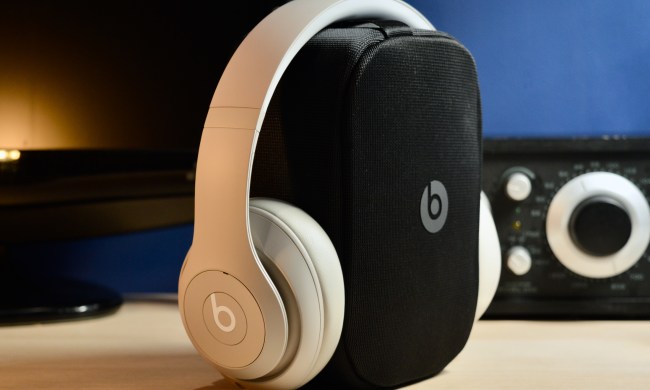
- Gorgeous design
- Perfect picture quality
- Stunning HDR performance
- Impressive sound system
- Google Assistant, Alexa Voice control
- Expensive
- Android TV can be a drag
What’s in a name? If that name is Sony, the answer is: quite a bit. The Japanese electronics titan has experienced some ups and downs over the past decade, but the past three years in particular have seen Sony surge straight to the heart of Premiumville. Sony’s cameras are the most competitive they’ve ever been, its headphones are best in class again, and its TVs have never been more beautiful. That premium quality comes with a premium price, however, and there is perhaps no more glaring example than the storied brand’s spanking-new OLED TV. As our Sony A1E OLED review points out, though, a TV this incredible might just justify its price.
When Sony announced the A1E OLED at CES 2017, we were understandably excited – finally LG had some competition, and that meant prices would fall in coming years. We were also faced with a very difficult decision when deciding on whether LG’s stunning W7 “Wallpaper” OLED or Sony’s A1E OLED would walk away with our Best Tech of CES award for the year.
In the end, the Sony won out. Caught up in the moment, we were wooed by its sleek design, a truly innovative audio system, and that classic Sony glow. As it turns out, long after the honeymoon is over, we’re still in love with the Sony A1E.
Out of the box
Setting up the Sony A1E OLED TV isn’t hard, per se, but it certainly isn’t simple. Whereas most TVs require little more than 5 minutes with a Philips-head screwdriver, the Sony requires a bit more time and a lot more muscle.
The Sony A1E is a sleek, gorgeous television that somehow commands attention from anyone who passes by.
Part of what makes the Sony such a stunning television is its unique easel-style stand, which allows the bottom of the TV to rest on an entertainment cabinet or credenza with zero gap underneath. To pull this design off, Sony had to add ballast to the easel extension to prevent the TV from tipping forward. Once the heavy piece is locked into place, a stabilizing bar must be installed to prevent the easel from collapsing.
With the stand assembly out of the way, the literal heavy lifting is done. The next step is to route cables through designated slots so that when the TV’s plastic cover plate is clicked into place, what’s left is a sleek, clean installation.
Even when wall-mounted, the TV requires a little extra muscle to work into place. The 55-inch version weighs 86 pounds, while the 65-inch version breaks the century mark at 108 pounds. Normally we suggest self-installers get a friend to help, but in this case having two more sets of hands would be a wiser plan.
You can see more for yourself in our setup video below.
The extra initial effort pays in spades. The Sony A1E is a sleek, gorgeous television that somehow commands attention from anyone who passes by. During our review period, we witnessed several DT staffers rubbernecking as they cruised by our review lab.
Sound
Typically, we launch this section by talking about picture processing or smart TV interfaces – and we’ll get to that – but this TV’s sound system is so noteworthy, we just had to start with the audio.
The Sony A1E OLED doesn’t have conventional speakers. You won’t find them tucked into the bottom bezel or laid out in a quasi-soundbar arrangement. Rather, the Sony A1E’s OLED screen is the speaker system.
Sony achieves this feat by placing actuators – small vibrating transducers – behind the screen on the left and right sides. The actuators buzz the screen, and the screen vibrates in kind, creating sound. Our simplified explanation may make the process sound crude, but the resulting sound quality is anything but.
To help round out the sound (the screen is prevented from producing any bass to preclude any visible vibrations) a small subwoofer is mounted on the rear of the TV. Combined, the sound quality is shockingly good – your mind will have a hard time wrapping itself around how this is possible. To be clear, the A1E OLED’s sound system is no match for a quality soundbar, but it far exceeds that of most TV sound systems. The design also allows the A1E OLED to pull off the impressive trick of making it seem as if voices are coming from actors’ mouths – something you won’t get from any soundbar.
Smart TV
Sony runs the Android TV platform, and while we’re glad the company is no longer trying to push its own idea of a smart TV system on us, we’re not exactly thrilled with Android TV’s implementation here. In our testing of five separate Sony TV models, we struggled with lagging interfaces, long load times, and general operational hassles. We’d prefer a Roku Ultra, thanks, so that’s what we used for most of our testing.
Android TV does come with some pretty fun features. For one, the TV has Google Cast built in, making casting content from a smartphone, tablet, or PC a piece of cake. The TV can also be controlled by Google Assistant using one of three Google Home speakers (the Google Home Mini is $50, and a lot of fun) or a smartphone. If you prefer Alexa, you can use Amazon’s digital assistant through its Echo speaker products to control the TV and launch programs (the Amazon Echo Dot is also just $50 and a lot of fun).
The other advantage to having Android TV is easy access to the Google Play store, where a mounting vault of movies in 4K HDR is available with just a few clicks or a quickly crafted voice command.
Still, these advantages are just bright spots in an otherwise cloudy smart TV system. Prepare to exercise some patience from time to time whenever navigating settings menus or switching from Netflix to Hulu.
The remote
Standard, simple, effective. You don’t get motion control or a slick touchpad, but you do get all the buttons you need and a microphone for voice commands.
Picture processing
We’ve been saying it for decades: Sony’s picture processing is among the very best available. That’s still true here. Even though the Sony A1E OLED uses an LG-manufactured OLED panel, it still has that tell-tale Sony look, and the motion processing is the very best out there – expect judder-free 24p films and smooth fast-action sports delivery.
The thing is, LG’s processing has come a long, long way in just a few short years, and is now on par with Sony’s. We put the LG E7 OLED against the Sony A1E OLED and the differences between the two were barely perceivable to the naked eye.
Picture performance
Simply stated, the Sony A1E OLED is one of the finest TVs ever made, and from a picture quality standpoint, it’s nearly perfect. Perfect black levels, outstanding out-of-the-box color performance, impressive peak brightness, and stellar HDR processing make the A1E OLED one of the three best TVs you can buy in 2017, and likely well into 2018. Everything it displays turns to gold.
Compared to LG’s OLEDs, Sony’s handling of specular highlights means you get more punch out of HDR material, though you give up on just the finest bit of detail in bright areas. Shadow detail is also excellent. Color saturation and color volume are impressive in both bright and dark rooms, and the TV’s input lag for gaming in 4K HDR mode sits around 30ms, making it suitable for most HDR gaming.
For now, the Sony A1E OLED doesn’t support Dolby Vision HDR, but the company promises that feature is coming soon via firmware updates.
Our Take
Seriously, folks, the Sony A1E OLED is just out-of-this-world fantastic. The question isn’t whether you will love having the Sony A1E OLED TV in your home. The question is whether can you stomach paying for the little extras it offers over competing LG sets. As of writing this review, the Sony A1E OLEDs, model per model, run about $500 more than the LG E7P series equivalents at Amazon.
Is there a better alternative?
From a value perspective, the LG C7P OLED series makes a lot more sense. The LG TV’s don’t bring the same kind of bling, but they excel where it counts most: picture quality and user experience.
How long will it last?
The Sony A1E OLED is very well future-proofed from a tech standpoint. The TV is built with the latest high-end processors, supports multiple HDR formats like HDR10 and Dolby Vision, and features smart TV apps that will stream the best 4K HDR content available, well into the future.
As for build quality, Sony is no slouch, and offers plenty of service and support in the U.S. We don’t anticipate any near-term operational issues.
Should you buy it?
Yes. If you want the absolute best and don’t mind paying more than a little extra for thoughtful design elements and fancy features, buy the Sony A1E OLED. Think of it as buying the Ferrari instead of the Audi. If, however, you are looking for better value bundled with outstanding picture, the LG C7P series is the smarter choice.














